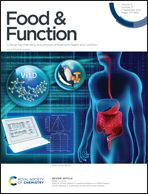Isobavachalcone ameliorates cognitive deficits, and Aβ and tau pathologies in triple-transgenic mice with Alzheimer's disease†‡
Abstract
Alzheimer's disease (AD) is a progressive neurodegenerative disorder that affects 50 million people worldwide. The current medicines have modest benefits in preventing or curing AD. Thus, it is urgent to discover drugs with the potential to change the progression of the disease. The primary clinical symptoms are memory loss and anxiety, while the critical pathological characteristics are Aβ plaques and hyperphosphorylated tau tangles. In this study, isobavachalcone (ISO), isolated from Psoralea corylifolia, was administered to 3×Tg-AD mice. It has been shown that this compound could significantly improve anxiety, memory and recognition deficits in the AD mice, attenuate the accumulation of Aβ oligomers, reduce the hyperphosphorylation of tau, and prevent the production of tau filaments. The metabolomic analysis implicates that the most probable pathways affected by ISO were bile secretion, tyrosine metabolism, and purine metabolism. In summary, ISO possesses the potential for further development as a drug candidate for AD.



 Please wait while we load your content...
Please wait while we load your content...